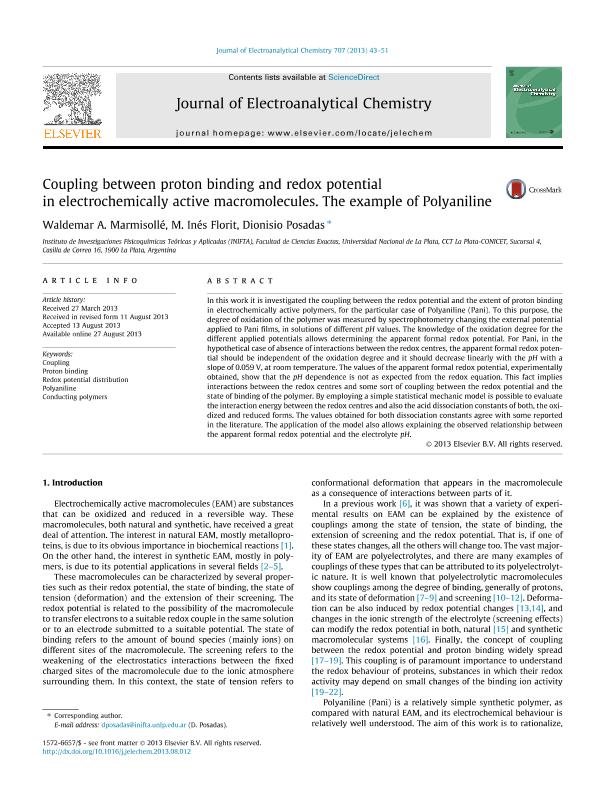Mostrar el registro sencillo del ítem
dc.contributor.author
Marmisollé, Waldemar Alejandro

dc.contributor.author
Florit, Maria Ines

dc.contributor.author
Posadas, Dionisio

dc.date.available
2019-08-20T20:54:58Z
dc.date.issued
2013-10-15
dc.identifier.citation
Marmisollé, Waldemar Alejandro; Florit, Maria Ines; Posadas, Dionisio; Coupling between proton binding and redox potential in electrochemically active macromolecules. the example of Polyaniline; Elsevier Science Sa; Journal of Electroanalytical Chemistry; 707; 15-10-2013; 43-51
dc.identifier.issn
0022-0728
dc.identifier.uri
http://hdl.handle.net/11336/81879
dc.description.abstract
In this work it is investigated the coupling between the redox potential and the extent of proton binding in electrochemically active polymers, for the particular case of Polyaniline (Pani). To this purpose, the degree of oxidation of the polymer was measured by spectrophotometry changing the external potential applied to Pani films, in solutions of different pH values. The knowledge of the oxidation degree for the different applied potentials allows determining the apparent formal redox potential. For Pani, in the hypothetical case of absence of interactions between the redox centres, the apparent formal redox potential should be independent of the oxidation degree and it should decrease linearly with the pH with a slope of 0.059 V, at room temperature. The values of the apparent formal redox potential, experimentally obtained, show that the pH dependence is not as expected from the redox equation. This fact implies interactions between the redox centres and some sort of coupling between the redox potential and the state of binding of the polymer. By employing a simple statistical mechanic model is possible to evaluate the interaction energy between the redox centres and also the acid dissociation constants of both, the oxidized and reduced forms. The values obtained for both dissociation constants agree with some reported in the literature. The application of the model also allows explaining the observed relationship between the apparent formal redox potential and the electrolyte pH.
dc.format
application/pdf
dc.language.iso
eng
dc.publisher
Elsevier Science Sa

dc.rights
info:eu-repo/semantics/openAccess
dc.rights.uri
https://creativecommons.org/licenses/by-nc-nd/2.5/ar/
dc.subject
Conducting Polymers
dc.subject
Coupling
dc.subject
Polyaniline
dc.subject
Proton Binding
dc.subject
Redox Potential Distribution
dc.subject.classification
Físico-Química, Ciencia de los Polímeros, Electroquímica

dc.subject.classification
Ciencias Químicas

dc.subject.classification
CIENCIAS NATURALES Y EXACTAS

dc.title
Coupling between proton binding and redox potential in electrochemically active macromolecules. the example of Polyaniline
dc.type
info:eu-repo/semantics/article
dc.type
info:ar-repo/semantics/artículo
dc.type
info:eu-repo/semantics/publishedVersion
dc.date.updated
2019-05-23T20:31:28Z
dc.journal.volume
707
dc.journal.pagination
43-51
dc.journal.pais
Países Bajos

dc.journal.ciudad
Amsterdam
dc.description.fil
Fil: Marmisollé, Waldemar Alejandro. Consejo Nacional de Investigaciones Científicas y Técnicas. Centro Científico Tecnológico Conicet - La Plata. Instituto de Investigaciones Fisicoquímicas Teóricas y Aplicadas. Universidad Nacional de La Plata. Facultad de Ciencias Exactas. Instituto de Investigaciones Fisicoquímicas Teóricas y Aplicadas; Argentina
dc.description.fil
Fil: Florit, Maria Ines. Consejo Nacional de Investigaciones Científicas y Técnicas. Centro Científico Tecnológico Conicet - La Plata. Instituto de Investigaciones Fisicoquímicas Teóricas y Aplicadas. Universidad Nacional de La Plata. Facultad de Ciencias Exactas. Instituto de Investigaciones Fisicoquímicas Teóricas y Aplicadas; Argentina
dc.description.fil
Fil: Posadas, Dionisio. Consejo Nacional de Investigaciones Científicas y Técnicas. Centro Científico Tecnológico Conicet - La Plata. Instituto de Investigaciones Fisicoquímicas Teóricas y Aplicadas. Universidad Nacional de La Plata. Facultad de Ciencias Exactas. Instituto de Investigaciones Fisicoquímicas Teóricas y Aplicadas; Argentina
dc.journal.title
Journal of Electroanalytical Chemistry

dc.relation.alternativeid
info:eu-repo/semantics/altIdentifier/url/https://www.sciencedirect.com/science/article/pii/S1572665713003627
dc.relation.alternativeid
info:eu-repo/semantics/altIdentifier/doi/http://dx.doi.org/10.1016/j.jelechem.2013.08.012
Archivos asociados
